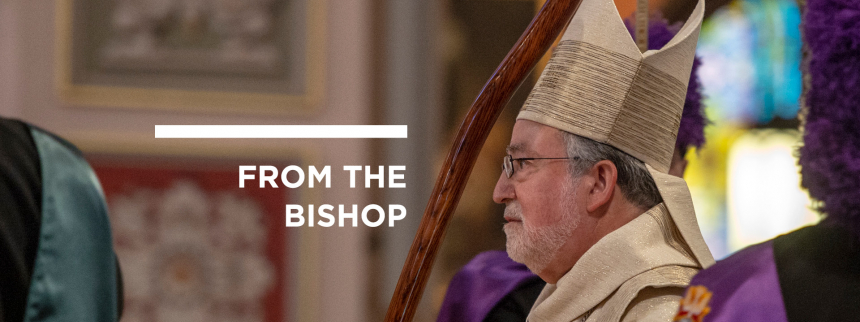
One of my favorite churches, besides the Cathedral of the Blessed Sacrament, is the beautiful Basilica of the Sagrada Familia (Holy Family) in Barcelona, Spain. Through the years I have visited this extraordinary House of God a number of times. Relatives on my father’s side of the family live in Spain. So on trips to visit them, I would often make Barcelona a side trip, dedicating an afternoon to the basilica.
On my first visit to the basilica many years ago, the structure seemed impossibly far from completion. The interior walls soared up into an open sky. The tour was conducted with the sounds of construction all around. The seemingly slow pace gave the impression that Jesus would bring the Parousia before this building was completed. In my more recent visits, I have wandered in wonder at the beautiful majesty of the basilica. Construction is still ongoing, but the building was completed enough to be dedicated by His Holiness, Pope Benedict, on Nov. 7, 2010. While largely built with stone, plaster and glass, the basilica is a living monument. During the day the sunlight, filtered through a kaleidoscope of stained glass, creates moving colors and shadows. The building sighs and quivers with life.
The artist who envisioned and designed the Basilica of the Sagrada Familia was Antoni Gaudi. He was an innovative pioneer of architecture. He died in 1926 and his body is buried in the crypt of his beloved basilica. There is a cause for his canonization. He was influenced by the growing modern movements in art, while at the same time having profound Catholic instincts. Borrowing from the renewed interest in bringing natural themes into art and architecture, he also believed that nature was filled with God’s grandeur. He was inspired by the gothic cathedrals of Europe and aspired to find a way to reconcile modern aspiration within the theological dimensions of a traditional Catholic Church. Walking into the basilica today gives the sensation of walking into heaven imagined as a garden, a paradise. Leaving behind the hectic streets of Barcelona, one comes into a rendering of the new heaven and earth prophesied in the Book of Revelation. (Rev 21:1)
A first impression of the art of Gaudi takes note of its busyness. Like a gothic or baroque building, there is a lot happening in the art. Gaudi brought a new appreciation for the wildness and seeming randomness of nature with unpredictable effects. Who can say how a branch will grow or in what way a rose will blossom?
For many years after his death his work and the basilica project were deplored, in large part due to the increasingly secularizing tendencies of culture and politics during the 20th century. These preferred clean, rational lines and shapes as signs of the progress of reason. The word “gaudy,” taken from his name, was introduced into the modern dictionary as a not very complementary reference to his work. It became the synonym for garish or outlandish styles. In recent times, the reputation of his art has gained a greater appreciation, culminating in the historic completion of most of the basilica and its dedication by Pope Benedict.
Much of the work of the basilica took place after his death. The artisans who assumed the project after Gaudi tried to remain true to his inspiration. The one major portion of the building that was completed during his lifetime was the façade of the Nativity. This magisterial creation literally has Gaudi’s fingerprints all over it. It is a garden of intricate beauty and alluring mystery. It commands time and attention to grasp the theological symmetry weaved into the busy array of heavenly and earthly images.
The façade faces east, where the light of each new day greets the “Dayspring from on High” (Lk 1:78) born in a manger. There are three grand porticos, representing the three theological virtues: faith, hope and charity. Charity is the central and largest of the doors. They are polychromatic displays of leaves hinting at the heavenly garden within.
Over the Door of Charity, the simple yet gravitational center of the whole façade, is the scene of Joseph standing over the Virgin Mary, kneeling in tender adoration of her Son, the Christ Child. Above them is a cluster of young angels leaning over the clouds and one another to catch a glimpse of the Holy Family. A pillar set in the middle of the angelic admirers is fashioned as the rays of the bright shimmering star that led the Magi to the newborn king. The band of shepherds is on one side of the charity portico. The Magi are on the other. Above each group are the heavenly hosts singing and blasting trumpets for the good news of salvation wrapped in swaddling clothes. All the figures emerge out of caves, trees, flowers, palm branches and clouds. In this dizzying façade, heaven and earth are truly assembled to witness the birth of the new creation.
The doors on the Nativity façade also follow Gaudí’s vision: celebrating the joy of life, through nature pic.twitter.com/KjAttDgvQz
— La Sagrada Família (@sagradafamilia) November 18, 2020
There is so much more to contemplate and admire about Gaudi’s Nativity façade. Most of the events of the Infancy narratives in the Gospels are represented in one fashion or another. I invite you to explore on the internet, if not in person, this amazing architectural meditation on the Incarnation.
Gaudi’s Catholic ingenuity recognized the Holy Family as a door into the marvelous mystery of God’s mercy. The intricate design of the façade can seem daunting at first. As one begins to move from one image to another, the façade draws the visitor into the story. Soon it becomes clear. The intense beauty of the façade gently reveals to its admirers the unsurpassable beauty of the Word Incarnate, Jesus. We see “his glory, the glory as of the Father’s only Son, full of grace and truth.” (Jn 1:14)

